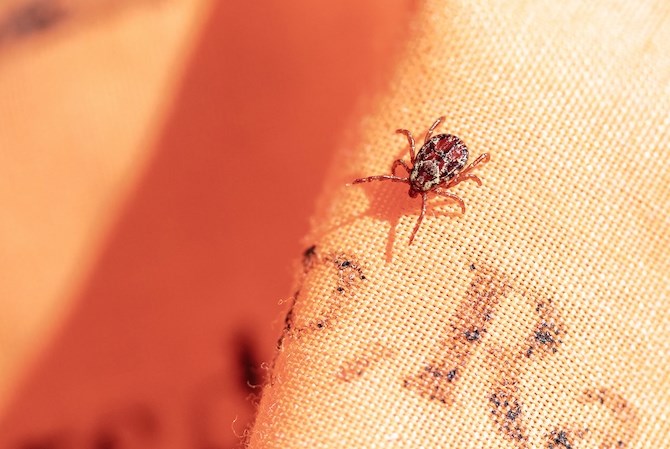
A Rocky Mountain wood tick is seen in this June 18, 2018 photo.
Image Credit: FLICKR / NPS / Jacob W. Frank
March 18, 2021 - 6:00 AM
There are two kinds of ticks in the Thompson-Okanagan that can cause harm to people, and one of them can cause temporary paralysis.
Once the snow melts, ticks start showing up in the region as early as February, Thompson Rivers University biology professor Rob Higgins said.
The most common tick people find is the Rocky Mountain wood tick, which doesn’t carry the Lyme disease-causing bacterium but can cause temporary paralysis if it attaches to a human for long enough.
“We’re still not exactly sure what’s going on in the case of tick paralysis," Higgins said. "We know the tick is secreting something that is causing these symptoms but what that is hasn’t been isolated."
Tick paralysis usually occurs two days after the tick has been attached and will start in the upper body before moving downward, he said. It’s most common in dogs but cattle are also impacted.
Even if the condition has progressed to a serious level, the removal of the tick will alleviate symptoms in about 30 minutes, he said. As long as the tick is removed within 24 or 48 hours there shouldn’t be any symptoms.
B.C. Centre for Disease Control will typically see six cases of tick paralysis a year.
Although he hasn’t conducted any research on it, “it’s kind of a hotspot (in the region) for this condition, it would be worth looking into some point,” Higgins said.
The tick that can carry Lyme disease is the Western black-legged tick, he said, and about 12 cases of Lyme disease are reported in B.C. each year so it’s not common.
“We’re not a preferred host for this tick, and we suspect that it likes to spend its nymph stages on lizards, in particular the north alligator lizard that is found in this area,” he said, adding it will also feed on deer mice, but doesn’t harbour the disease-causing bacteria as much as ticks do in Eastern Canada.
The tick has to be attached for a few days to spread the bacteria and is about the size of a sesame seed. It has a painful bite so people tend to notice it, he said, as opposed to the Rocky Mountain wood tick, which is easier to spot as it’s larger but doesn’t have a painful bite.
They both will be found on humans mostly on the scalp, he said. Ticks will find hosts by climbing to the tops of tall grass to hitch a ride.
To remove a tick, use tweezers slid underneath and atop the insect’s back followed by a gentle pull back.
“Never use a lot match or gasoline to irritate it because that could cause it to regurgitate and if it’s carrying some form of infection it’s more likely that it’ll be transmitted in that moment of extreme agitation,” Higgins said.
For more information on ticks, visit this Interior Health web page.
To contact a reporter for this story, email Carli Berry or call 250-864-7494 or email the editor. You can also submit photos, videos or news tips to the newsroom and be entered to win a monthly prize draw.
We welcome your comments and opinions on our stories but play nice. We won't censor or delete comments unless they contain off-topic statements or links, unnecessary vulgarity, false facts, spam or obviously fake profiles. If you have any concerns about what you see in comments, email the editor in the link above.
News from © iNFOnews, 2021